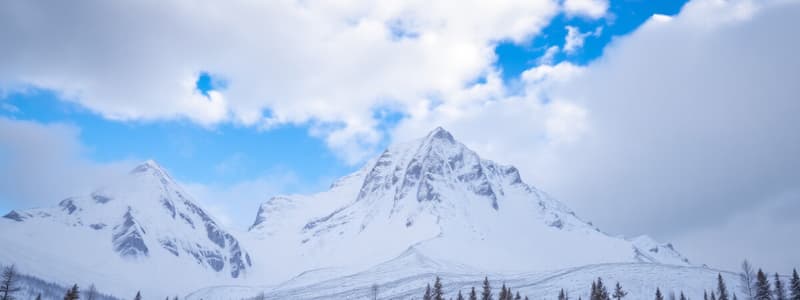Podcast
Questions and Answers
What factor contributes to the colder temperatures in Canada compared to other countries at similar latitudes?
What factor contributes to the colder temperatures in Canada compared to other countries at similar latitudes?
- Geographical isolation
- Population density
- Latitude (correct)
- Ocean currents
Which type of weather system is characterized by rotating winds converging towards a low-pressure center?
Which type of weather system is characterized by rotating winds converging towards a low-pressure center?
- Anticyclones
- Tropical storms
- High pressure systems
- Cyclones (correct)
What are fronts in meteorology?
What are fronts in meteorology?
- Regions of heavy rainfall
- Areas of high temperature
- Types of ocean currents
- Boundaries between different air masses (correct)
Which region in Canada typically receives more precipitation?
Which region in Canada typically receives more precipitation?
What type of weather conditions do anticyclones typically bring?
What type of weather conditions do anticyclones typically bring?
What often influences the wind patterns in Canada?
What often influences the wind patterns in Canada?
Which season typically experiences the most extreme temperature differences in Canada?
Which season typically experiences the most extreme temperature differences in Canada?
Which of the following does NOT characterize severe weather in Canada?
Which of the following does NOT characterize severe weather in Canada?
What characterizes the Arctic regions?
What characterizes the Arctic regions?
How does climate change affect weather patterns in Canada?
How does climate change affect weather patterns in Canada?
What is a primary consequence of changing weather patterns related to climate change?
What is a primary consequence of changing weather patterns related to climate change?
Which phenomenon is characterized by warm, dry winds from the Rocky Mountains?
Which phenomenon is characterized by warm, dry winds from the Rocky Mountains?
What role do sophisticated technologies play in weather forecasting in Canada?
What role do sophisticated technologies play in weather forecasting in Canada?
How does Lake Effect Snow occur?
How does Lake Effect Snow occur?
What describes the climatic conditions of Central Canada?
What describes the climatic conditions of Central Canada?
What conditions define a blizzard in Canada?
What conditions define a blizzard in Canada?
Who is André Robert
Who is André Robert
Flashcards
Cyclone (Low-pressure System)
Cyclone (Low-pressure System)
A weather system with converging winds rotating towards a low-pressure center. Often brings rain or snow and strong winds.
Anticyclone (High-pressure System)
Anticyclone (High-pressure System)
A weather system with diverging winds radiating outwards from a high-pressure center. Usually brings clear skies and light winds.
Front
Front
The boundary between two different air masses. Can bring sudden changes in temperature and precipitation.
Latitude
Latitude
Signup and view all the flashcards
Topography
Topography
Signup and view all the flashcards
Ocean Currents
Ocean Currents
Signup and view all the flashcards
Air Masses
Air Masses
Signup and view all the flashcards
Atmospheric Pressure
Atmospheric Pressure
Signup and view all the flashcards
Western Canadian Climate
Western Canadian Climate
Signup and view all the flashcards
Lake Effect Snow
Lake Effect Snow
Signup and view all the flashcards
Chinook Wind
Chinook Wind
Signup and view all the flashcards
Blizzard
Blizzard
Signup and view all the flashcards
Central Canadian Climate
Central Canadian Climate
Signup and view all the flashcards
Climate change on Canadian weather
Climate change on Canadian weather
Signup and view all the flashcards
Weather Monitoring and Forecasting
Weather Monitoring and Forecasting
Signup and view all the flashcards
Arctic Climate
Arctic Climate
Signup and view all the flashcards
Study Notes
Canadian Weather Systems
- Canada's weather is diverse, varying significantly across the country due to its vast size and diverse geography.
- Factors influencing Canadian weather patterns include:
- Latitude: Canada's northerly location results in colder temperatures than other countries at similar latitudes.
- Topography: Mountain ranges and valleys affect local precipitation and temperatures.
- Ocean currents: The influence of the Pacific and Atlantic Oceans affects coastal regions.
- Air masses: Different air masses (polar maritime, continental polar, etc.) bring distinct weather types.
- Atmospheric pressure systems (cyclones and anticyclones): These systems drive wind patterns and influence precipitation.
Major Canadian Weather Characteristics
- Temperature variation: Wide temperature ranges exist across Canada, from extreme cold in the north to moderate temperatures in the south. Seasonal variations are pronounced, with significant temperature differences between summer and winter.
- Precipitation: Canada experiences different types of precipitation, such as rain, snow, sleet, and hail. Precipitation patterns vary significantly across the country and also depend on the season. Coastal regions generally receive more precipitation than interior regions.
- Wind patterns: Wind patterns in Canada are influenced by pressure systems, topography, and the presence of large bodies of water. Strong winds frequently occur in the prairies and interior regions, while coastal regions may experience sea breezes.
- Severe weather: Canada experiences various severe weather events, such as blizzards, ice storms, thunderstorms, and tornadoes. These events can cause significant disruptions to daily life in affected regions.
Key Weather Systems
- Cyclones (Low-pressure systems): Characterized by rotating winds converging towards a low-pressure center. Cyclones often bring periods of rain or snow, along with strong winds.
- Anticyclones (High-pressure systems): Associated with diverging winds radiating outwards from a high-pressure center. Anticyclones typically bring stable weather conditions, such as clear skies and light winds.
- Fronts: Boundaries between different air masses. Cold fronts can bring sudden changes in temperature and precipitation, while warm fronts tend to bring gradual changes.
Regional Weather Variations
- Arctic regions: Characterized by extremely cold temperatures, long periods of winter, and limited precipitation mostly in the form of snowfall.
- Western Canada: A mix of climates ranging from dry and sunny prairies to cool and wet coastal regions, with mountain ranges influencing precipitation patterns.
- Eastern Canada: Affected by Atlantic winds, often featuring more precipitation, milder winters, and higher humidity compared to the interior regions.
- Central Canada: A transition zone with a variety of climate patterns between the extremes of the west and east.
Climate Change and its Impact
- Recent studies indicate that climate change is affecting various aspects of Canadian weather trends, including temperature increase, changes in precipitation patterns, and increased frequency of extreme weather events.
- Consequences of changing weather patterns can include:
- Sea Level Rise and Coastal Impacts
- Changes in River Flow
- Changes in seasonal cycles and plant growth
- Impacts on agriculture, forests, and other ecosystems
Weather Monitoring and Forecasting
- Governments and scientific organizations employ sophisticated technologies to monitor and predict weather patterns in Canada.
- Data is collected from various sources, including weather stations, satellites, and radar systems.
- Weather forecasts utilize this data to predict future conditions, aiding in public safety and various economic activities.
Common Canadian Weather Phenomena
- Chinook winds: Warm, dry winds that descend from the Rocky Mountains, significantly increasing temperatures in the lee of the mountains.
- Lake Effect Snow: Intense snowfall that occurs when cold air moves over relatively warmer bodies of water, picking up moisture and dropping it as snow downwind from the lake.
- Blizzards: Severe winter storms characterized by low visibility due to blowing snow, strong winds, and dangerously cold temperatures.
Studying That Suits You
Use AI to generate personalized quizzes and flashcards to suit your learning preferences.





